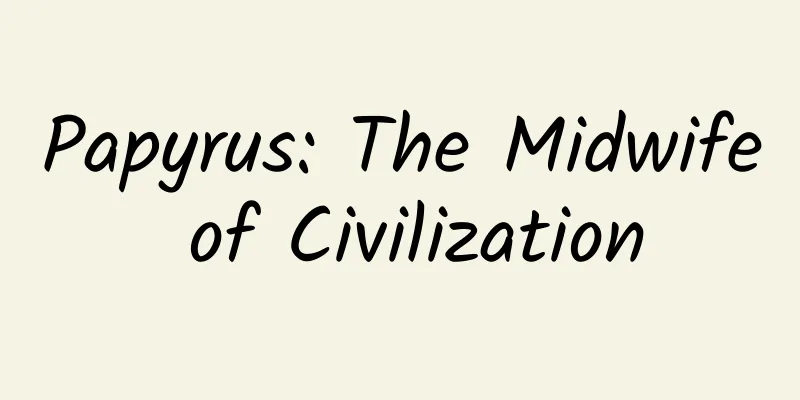Papyrus: The Midwife of Civilization

|
Produced by: Science Popularization China Author: Zhu Lijie (Beijing Botanical Garden, Institute of Botany, Chinese Academy of Sciences) Producer: China Science Expo In 1862, British explorer Samuel White Baker and his wife Florence completed an important expedition. They determined that the White Nile, an important tributary of the upper Nile, originated from a large, undiscovered lake, which they named Lake Albert after Queen Victoria's husband. This expedition brought them fame and success. It was during this expedition that they came across the now-famous papyrus. Samuel White Baker (Image source: self-made by the author) Fireworks Erupting from the Mud: The Discovery of Papyrus The Bakers traveled all the way to the confluence of the White Nile and its tributaries, the Ghazal River, the Jur River, and the Tonj River - the lowlands in central South Sudan. The terrain here is low and flat, with a dense network of rivers. During the rainy season, the rivers overflow and the land becomes a swamp. The endless swamps are covered with floating aquatic plants, which the locals call "Sud", so this swamp is called the "Sud" swamp. Papyrus grows wildly in the mud of this swampy shallows. New rhizomes constantly cover old rhizomes, stretching out on the water surface. Tender shoots grow on the nodes of the thick rhizomes, and the tender shoots develop into stems. Asexual reproduction using rhizomes or underground stems is a common reproductive method for monocots . Plants such as bamboo and buffalo grass all use this low-key and hidden breeding method to silently increase their population. This is a very practical way of self-protection. Because no matter the above-ground part is eaten by animals or burned by wildfires, the underground stems buried deep in the soil will not be damaged. There are nodes on the stems, and buds on the nodes. When the time is right, the buds will sprout new individuals. It is true that wildfires cannot burn them all, and spring breezes will bring new life. Papyrus (Image source: self-made by the author) As professional explorers, the Bakers have traveled extensively and seen a lot of sedges all over the world. Those sedges are short and thin, only about 60 to 70 centimeters long, and not very attractive in appearance. However, the majestic and majestic appearance of the papyrus in front of them made them "drop their jaws". The three-sided stems are two to three meters high, upright and tall, growing in clusters like bamboos, intertwined and closely connected, forming a spectacular floating island. At the top of the stem are several involucral bracts, clustered together like umbrella stalks. The involucral bracts are leaf-lanceolate, swaying in the breeze, and from a distance they look like bursts of fireworks. The floating islands are connected to each other and stretch out, densely packed like a sea of bamboo. This may be the first time that modern Westerners saw papyrus in its natural environment. I wonder what the Bakers thought at that time? This scene should have been seen when they set foot on the land of North Africa, in the Nile Delta, where hundreds of millions of tons of papyrus were once made into papyrus and sold to West Asia and the Mediterranean coast, nourishing Arab and Western civilizations. But as papyrus withdrew from the stage of history, the swamps and lakes where papyrus grew in the past have been filled and reclaimed into farmland. This fertile land has been planted with new cash crops such as cotton, rice, wheat, sugar cane, and dates. The once glorious papyrus has disappeared. It is really fate's trick. The Application of Cyperus, a Necessity of Life in Ancient Egypt Papyrus is a type of sedge, which was once a necessity in the lives of the ancient Egyptians. As early as the Stone Age, the ancient Egyptians who settled in the Nile Delta had already used papyrus to build thatched houses and make boats. Sedge boats are similar to rafts and bamboo rafts. Instead of using the hull structure to generate buoyancy, they use the structure of each sedge itself to keep the object floating on the water. Sedge boat (Image source: self-made by the author) In appearance, sedge and reed are somewhat similar, but reed is a grass plant, while sedge is a sedge plant. Like rice and wheat, reed stems are hollow. The outer skin of sedge stems is tough, and the inside is a medullary tissue composed of thin-walled cells. The medullary tissue stores rich sugar and protein. To this day, some Africans use the medullary tissue of sedge as food. During the maturation process of sedge, the thin-walled cells in the pith will initiate "programmed death", breaking down the macromolecules such as stored proteins and gradually transporting them to the developing grains. Most plants do this. After the dehydration process, the original cells are left with only the cell walls, like empty little houses. This is what Robert Hooke first saw under a microscope, of course, he was observing oak. These "little houses" are filled with air, like sponges, and also like the compartments of a large ship, which reduces the density of the sedge stems, so that the boat made of sedge can float on the water. This structural feature is also very suitable for keeping warm, which brings us to another application of sedge: boots. Older people know the "Three Treasures of Northeast China": ginseng, mink fur, and Ula grass. Ula grass, in fact, should be called "靰鞡草", which is also a member of the Cyperaceae family. 靰鞡 is Manchu, which means shoes made of cowhide and worn in winter. They look a bit like buns, and the uppers are all pleated. The warmth of 靰鞡 covered with Ula grass is comparable to that of snow boots. Hunters and loggers can work all day in extremely cold conditions without freezing their feet. But this kind of sedge cannot be made into papyrus because their stems are too thin and there is little left after removing the skin. Boots (Image source: self-made by the author) In addition, papyrus has slender stems and a tough outer skin, making it an excellent material for weaving. The ancient Egyptians also used it to weave straw sandals, sails, and baskets. Papyrus weaving (Image source: self-made by the author) Connections Across Mountains and Rivers: Chinese Papermaking and Papyrus Although papyrus had many applications, the most famous one is papyrus. Around the 8th and 9th centuries AD, China's advanced papermaking technology was introduced to the Arab region. Since then, papyrus has gradually been replaced and eventually withdrew from the stage of history. The production process of papyrus has also been lost in the long river of history. In the 1960s and 1970s, Egyptian engineer Hassan Ragab "revive" this craft inspired by traditional Chinese papermaking and papyrus. Simply put, the stems of papyrus are cut into small pieces of 40 to 50 centimeters, the outer skin is removed, and the pith is left. The pith is then cut into thinner slices, stacked together in a criss-cross pattern, compacted and squeezed to remove moisture. Finally, the sugar in the cells will stick them together, and then after polishing and other processes, it becomes papyrus. Although papyrus is called paper, it is not real paper. Because there is no step of preparing pulp in its processing, nor is there any uniform preparation of plant fibers, and it is impossible to achieve mass production. Of course, there is a huge difference in quality between papyrus and real paper, so papyrus cannot withstand the impact of pulp paper. Chinese papermaking is to prepare pulp made of plant fibers by cutting and boiling different materials. With pulp, paper with uniform texture can be made. The most important feature of this papermaking method is that it can be mass-produced, which is also the greatness of Chinese papermaking. Papyrus is not real paper, but it brought lasting civilization to the world. Papyrus, an important carrier of civilization The outer skin of papyrus can be used in various ways, and the pith, which is removed from the outer skin, may be used as food or abandoned. One day more than 5,000 years ago, under unknown circumstances, the ancient Egyptians actually made papyrus paper from the pith of the soft papyrus. The ancient Egyptian who made the first papyrus could never have imagined that his invention would have a profound impact on the development of ancient Egypt, West Asia, the Mediterranean, the whole of Europe and even world civilization. American scholar John Gaudet published a popular science book, Treasures of the Pharaohs, which systematically introduced the impact of papyrus on the development of civilization. The few paragraphs on the cover gave an accurate evaluation of the historical significance of papyrus. Papyrus is a legend of human endeavor, and it has existed for more than three quarters of recorded human history. It was a key carrier of Greek and Roman civilizations… It was once the world’s most commonly used medium of communication, driving innovations, sparking revolutions, and having an interesting and colorful history. Papyrus was the midwife of the birth of civilization, cutting the umbilical cord that bound the development of civilization. When I first saw Euclid's "Elements", I wondered what materials did Euclid, an ancient Greek mathematician who was born between 200 and 300 BC, use to write such a thick book? Let us imagine what the scene would be like if Euclid wrote "Elements" using clay tablets, stones, shells, and wood chips? I guess you would have to build several large houses to hold this book. Archaeological discoveries show that, except for the Elements of Geometry, all the works of ancient Greek sages and philosophers were written on papyrus. It can be said that without papyrus, the progress of Western civilization would be delayed by many years. Why papyrus became the dominant writing medium When papyrus became the main writing material in North Africa, West Asia and Europe, the Chinese chose bamboo slips, which have been used in China for more than 2,000 years and have played a huge role in promoting the spread of ancient Chinese thought and culture. Egypt does not produce bamboo, and China does not have papyrus. But why among thousands of plant species, only papyrus and bamboo were chosen by ancient ancestors to make writing media? This is inevitable as they have common characteristics - fast growth and high yield. Someone has calculated that every acre of bamboo can produce 1.5 to 2 tons of bamboo, and the yield of papyrus is even more amazing, reaching 3 to 4 tons of dry matter per acre, which is difficult for most plants to achieve. Without strong growth capacity, it is impossible to support the huge market demand. In ancient Rome, there was a situation where the papyrus supply was insufficient due to poor harvest, which led to difficulties in government work. The study found that papyrus in the Nile River basin grew at an astonishing rate. This is not surprising at all. The papyrus in the Nile Delta has almost everything going for it. Plant growth depends on light, temperature, water and fertile soil. The Nile Delta has high temperatures and little rainfall in most of the summer, but there is no shortage of water. The Nile River flows down from its source, passing through forests and grasslands, carrying a large amount of minerals and humus, providing the most fertile soil for the downstream plains. Conclusion The genetic characteristics and physiological structure of papyrus itself are also important factors in its ability to grow rapidly and accumulate a large amount of photosynthetic products. Why does it grow so fast? This is still a scientific question worth studying. Even if we no longer need papyrus today, papyrus may still play a new role as an important resource plant one day in the future. Editor: Guo Yaxin |
<<: Where do all the old clothes I throw in the recycling bin end up?
>>: Taking stock of different ball sports, who is the “king of balls”?
Recommend
After wading through water after rain, beware of these skin diseases
After heavy rain, prevent infectious diseases, es...
Ten thousand words of practical knowledge | The methodology for 10 times user growth is all here
Growing is not an easy job because you face so ma...
2019 brand promotion direction and channels!
2019 was a pretty boring year for branding . We c...
Chemical pollution cannot be ignored. How much do you know about space station cleaning?
Recently, a study showed that the concentration o...
How much does it cost to develop a flash sale mini program in Shuangyashan?
How much does it cost to develop a Shuangyashan f...
√2 caused a stir in the mathematical world, and some people even sacrificed their lives for it...
I wonder if you have ever thought seriously about...
The history of the hot money war in China: Huge profits in the top hot money battlefield, A-share hot money biography series PDF
[Hunan Tough Guy] History of the Hot Money War in...
Information flow promotion, analysis of 7 excellent case studies and techniques!
For third-party optimizers, who deal with clients...
How to plan a successful and beautiful offline event?
As an operator , event promotion ( event operatio...
For B-side operations, you should master the thinking patterns and common sense!
1. Discussion The reason for writing this article...
How to name your website? How to name a Google website?
The name and domain name of the website cannot be...
Tencent suddenly lifted restrictions on WeChat: Google and Bing can search for public account articles, but Baidu cannot
In the era of mobile Internet, many apps have beg...
Compare! Which factors that cause liver cancer have you come into contact with? How to prevent liver disease? Save!
Liver cancer is a malignant tumor that occurs in ...
Experts comment on the competition for super TVs: LeTV competes openly with Konka and secretly with Tencent
On March 18, the Internet smart TV "T60 Supe...
Let’s follow the tree doctor to do an “ultrasound” on the ancient trees
B-ultrasound is an important detection technology...









